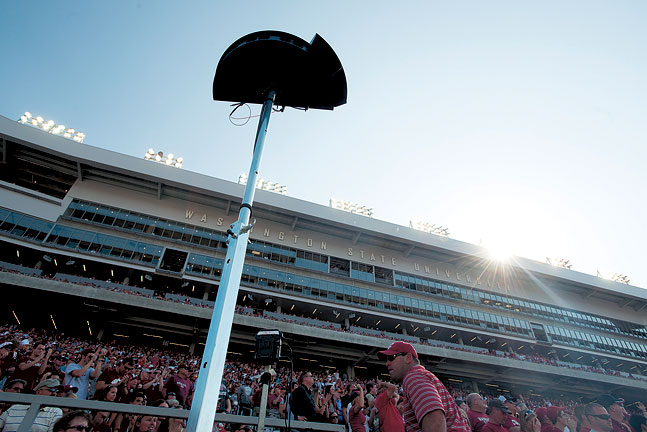The idea of having control of his view of a sporting event struck Sankar “Jay” Jayaram in 2009 while he was watching a Seahawks game on TV and wishing he was in the stands.
“I had never been to a Seahawks game and I wished I could put on a 3D headset and be in the stadium,” says the Washington State University mechanical engineering and computer science professor.
Fortunately Jayaram, an expert in virtual reality modeling, had been working for several years on an immersive 3D experience for use on exercise machines. His startup firm 3D-4U Solutions holds patents on the technology which creates 180- or 360-degree views with multiple panoramic cameras and sends the video to processing. Users can then put on a 3D headset, and control their view of a recorded scene, switching between cameras, panning left or right, and zooming in and out and pausing when they want.
In addition to exercise experiences, Jayaram and his team created a prototype and filmed a museum in Utah in which viewers can walk around a dinosaur and examine it in 3D. The idea was to show that viewers could do things like virtually tour the Louvre or ride a stationary bike through the Alps or Africa.
The company started to focus on sports in 2009, placing cameras around fields and arenas. The first test came in 2010 with a National Basketball Association game between the Washington Wizards and Atlanta Hawks, followed by Major League Baseball games and a Virginia Tech football game.
It wasn’t always an easy task. “We filmed the Apple Cup two years ago when it was here,” says Jayaram. “It was 14 degrees. The night before, our fiber optic cables froze and our camera had stopped working, and in the morning water was dripping into our production truck. Ice had formed on the inside of the truck and water was pouring onto our servers.” Nonetheless the engineers made it through the day.
They next had a test run at the World Series in St. Louis in 2011. Jayaram and the company decided it was time to launch an in-venue application, and approached WSU about recording the Cougs’ home football games in 2012.
“When the opportunity came along to put it in at WSU, I was ecstatic,” he says. “I’m a season ticketholder of Cougar football for many years. My son and I don’t miss a single home game unless we’re traveling, so for me to put it here was huge.”
In three short months toward the end of the Martin Stadium renovation, the company put the 3D-4U cameras and technology in place. Guests in each of the new luxury suites had access to racks of 3D glasses, the four unique 3D-4U camera feeds, and flat screens connected to video game controllers, with which they could control both live views as well as playback of any of the four camera perspectives.
“Each camera is situated in such a way that it can see from end zone to end zone,” says Martin Andersen, vice president of production and marketing at 3D-4U Solutions. “They can control [the view they receive from] any one of these cameras.”
Another feature debuted last fall at the UCLA-WSU game was a mobile app for iPad and iPhone. Although it wasn’t 3D, people attending the game could still access the multiple views, pause the game, zoom and pan on their devices. It has been universally popular, says Jayaram. “When I was showing them, everyone from the 75-year-old grandma to the teenagers wanted to have it.”
“Fans are begging for more opportunities to see replays and this puts it right in their hands,” says Andersen. He adds that a concierge service built into the mobile app will show statistics, scores from other games, and even products users can buy, such as tickets, clothing, and food. When you register your app, merchants will know your seat number. You will be able to send in your order, pay for it on your iPad, and they will bring it to your seat, he says.
Jayaram says the response to the 3D feeds has been positive, but varies with age. “The younger people are glued to this in 3D. A lot of the older people don’t like the 3D because it bothers them with their bifocals.”
Now that the WSU football games have shown the technology works well, 3D-4U and Jayaram have been talking to National Football League teams, other universities, and ice hockey and soccer teams in Europe and the Middle East.
Beyond sports, the 3D-4U system has potential for education, with virtual field trips. And, Jayaram says, virtual 3D concerts might be the next application.
Security could be another use of the technology. “We could have one of these systems set up at the presidential inauguration and have a room full of Secret Service people, each looking at a different aspect of what is going on in the crowd,” says Jayaram. “It’s like having eyes all around and feeding the view to as many people as you want.”
Even though the 3D-4U technology has global opportunities, the company and its staff have strong ties to Pullman and WSU. In addition to being housed at the WSU Research Park, many of the engineers and staff are WSU alumni or are otherwise connected to the University, including Jayaram’s wife Uma, a WSU engineering and computer science associate professor.
Jayaram says 12 of 13 engineers have a degree from WSU. “Our university has some really sharp students. I understand why a lot of people in industry like our students,” he says. “I like to hire from WSU because I find them very grounded and very practical and very innovative.”
On the web
Voke VR (formerly 3D-4U Solutions)
Web extra
Video: 3D-4U Solutions introduces replays at your fingertips


